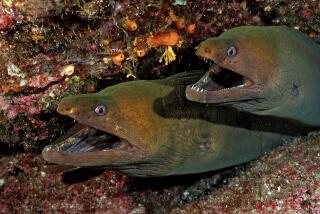Jellies: Phantoms of the Deep
- Share via
Jellyfish have no brains and no hearts and aren’t really fish at all. Yet these mysterious and beautiful creatures have existed for more than 650 million years -- longer then dinosaurs and sharks. The Long Beach Aquarium of the Pacific explores this diverse and adaptable life form in it’s new exhibit “Jellies -- Phantoms of the Deep”, which opens Friday, June 16th. More about jellies:
*
(Main parts of the jellyfish)
Bell
Radial canal
Stomach
Mouth
Rhopalium (sensors)
Oral arm (pulls food towards mouth)
Tentacle
MOVEMENT
A sea jelly stays afloat and propels itself short distances by opening and closing its “bell”. They drift great distances as it drifts in ocean currents.
*
Life Cycle
1. Medusa (adult form): Reproduces by releasing eggs or sperm in the water. Fertilized eggs become planula.
2. Planula: Free-swimming larvae that settle on hard surfaces such as pilings and rocks.
3. Polyp: Develops into multiple body segments (strobila). Can clone itself asexually.
4. Strobila separate and float away as free-swimming ephyra.
5. Ephyra: Matures into adult medusa form.
*
The Sting
1. Tentacles contain thousands of stinging cells (cnidocytes) that activate automatically when something brushes against them.
2. Stinging cells burst upon contact, launching barbed, harpoon-like stingers (nematocysts) into the victim’s skin.
3. Venom injected into victim through thread-like tubes attached to barbs.
*
* Food: Phytoplankton, zooplankton and other sea jellies, which they catch using their tentacles.
* Predators: Vital source of food for sea turtles, blue rockfish, some sea birds and sunfish (mola mola).
*
Jelly Facts:
* A large group is called a “smack”.
* Found in all oceans of the world and in some freshwater lakes.
* Some have a fluorescent protein in their bodies that creates light (bioluminescence). Others have tiny cilia that reflect existing light (iridescence).
* Are 95% water.
* Can sting long after death.
* Are related to corals and sea anemones.
* The lion’s mane jelly has tentacles that can grow to 100 feet (longer than some whales).
* Have crude sensors that detect light and which way is up or down.*
Sustaining Life In The Tanks
Jellies are fed brine shrimp and displayed in round tanks (kriesals) with continuous water circulation to keep them afloat.
Screened drain: Draws off water for filtration.
Spray bar: Pumps jets of filtered water across the drain to keep jellies from getting stuck to it; moves water through the tank in a gentle, circular motion.
*
Long Beach Aquarium of the Pacific
Address: 100 Aquarium Way, Long Beach
Hours: 9 a.m. to 6 p.m. daily, except Christmas Day
Admission: Adults (ages 12-59) $14.95; Children (ages 3-11)$7.95; Seniors (60 and up) $11.95. Ages 2 and under free.
General information: 562-590-3100
Web site: https://www.aquariumofpacific.org
Graphics reporting by JANICE JONES DODDS and DORIS SHIELDS/Los Angeles Times
Source: Long Beach Aquarium of the Pacific
More to Read
Sign up for The Wild
We’ll help you find the best places to hike, bike and run, as well as the perfect silent spots for meditation and yoga.
You may occasionally receive promotional content from the Los Angeles Times.






